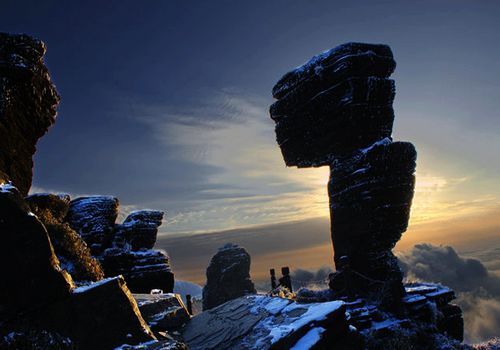Top 10 mountains in China for summer vacation
china.org.cn / chinagate.cn by Xu Lin, January 21, 2014 Adjust font size:
During the scorching summertime, the heat may keep you locked inside your air-conditioned living room or office and prevent you from venturing outside, let alone travel around. We have some good news for you though! A number of famous Chinese mountains, with their charming sceneries and favorable climates, are your ideal vacation alternatives for this summer.
The latest ranking of the most prominent mountains in China for summer vacation has been released, listed according to the following criteria: distinctive regional culture, complete natural eco-system, favorable weather in summer and rich tourism resources.
Mount Emei in Sichuan Province was crowned the best mountain to visit in summer, followed by Mount Wutai in Shanxi and Mount Huangshan in Anhui.
Here are the top 10 mountains in China to spend your summer break.
Fanjing Mountain(梵净山)
|
Fanjing Mountain [File photo] |
Known as the No.1 mountain in Guizhou and the highest of the Wuling Mountain Range, Fanjing Mountain is situated at the intersection of the three counties of Jiangkou, Yinjiang and Songtao in Tongren City of Guizhou Province. Its highest peak -- Mount Phoenix -- stands at 2,572 meters above sea level. In 1986, it was listed as one of the first national nature reserves in all of China and was brought under the protection of UNESCO's Man and Biosphere Program.
Fanjing Mountain became a sacred Buddhist site during the Ming Dynasty (1368-1644). It has been as famous as Mount Emei, Mount Wutai, Mount Putuo and Jiuhua Mountain for a long time. However, the mountain is now better known for its magnificent natural landscape and subtropical ecology featuring rare plants and wildlife. The more than 80-meter-high Larger Golden Peak at the top of the mountain offers a fantastic view: a steep stone pillar supporting a huge square rock known as the "Pile of 10,000 Books." The most precious wildlife and plants species include the golden monkey and the Chinese dove tree.
Visitors can feast their eyes on the sights of the mountains shrouded in mist and clouds, their beautiful vegetation, steep cliffs, echoing caverns and ancient bridges. Those lucky enough will perhaps witness the mysterious spectacles of Buddha's light and the projection of human shadows onto the fog. Also, don't forget to check out the authentic ethnic cultures of the Tujia, Miao, Dong and Qiang minorities at the foot of the mountain.
Admission: 110 yuan (US$18.17) / person (peak season);
90 yuan (US$14.87) / person (off-season)




